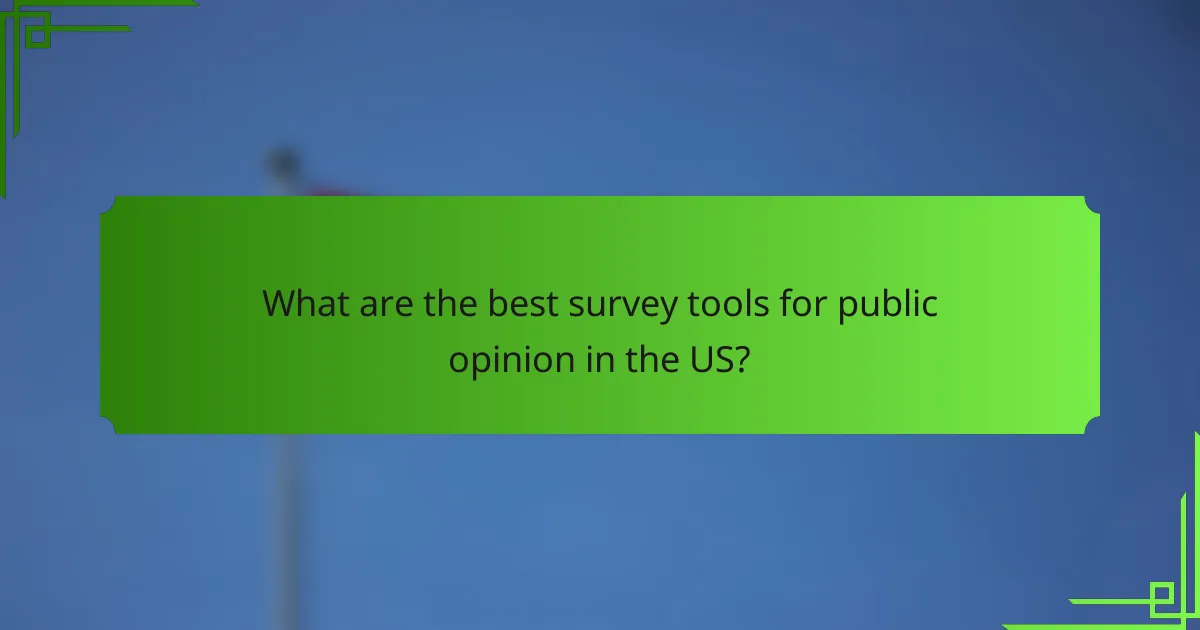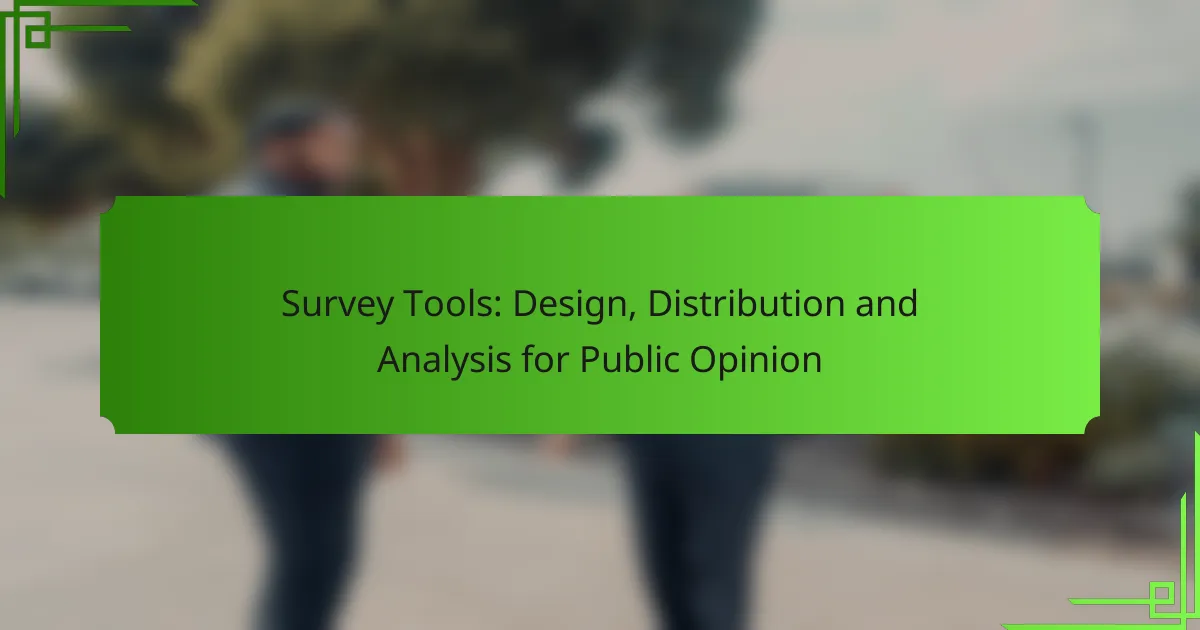Survey tools play a vital role in capturing public opinion, offering various features tailored to different needs. Effective survey design focuses on clear and relevant questions that engage respondents, while strategic distribution maximizes response rates and data quality. By leveraging tools like SurveyMonkey and Google Forms, researchers can efficiently gather and analyze insights that inform decision-making.

What are the best survey tools for public opinion in the US?
The best survey tools for public opinion in the US include SurveyMonkey, Google Forms, Qualtrics, Typeform, and Microsoft Forms. Each tool offers unique features and pricing structures, making them suitable for various survey needs and audiences.
SurveyMonkey
SurveyMonkey is a widely used survey tool that allows users to create customizable surveys with various question types. It offers both free and paid plans, with the paid options providing advanced analytics and reporting features. This platform is ideal for businesses and organizations looking to gather detailed feedback from their audience.
When using SurveyMonkey, consider its user-friendly interface and template library, which can save time in survey design. However, be mindful of the limitations on responses and features in the free version, which may not meet the needs of larger projects.
Google Forms
Google Forms is a free tool that integrates seamlessly with other Google Workspace applications. It allows users to create simple surveys quickly and share them easily via links or email. This tool is particularly useful for individuals or organizations on a budget who still want to collect valuable public opinion data.
While Google Forms offers basic analytics, it lacks some advanced features found in paid survey tools. However, its simplicity and ease of use make it a popular choice for quick feedback collection and informal surveys.
Qualtrics
Qualtrics is a robust survey platform designed for professional research and data analysis. It offers advanced features such as branching logic, custom branding, and extensive reporting capabilities. This tool is particularly suited for academic institutions and large organizations that require in-depth analysis of public opinion data.
Keep in mind that Qualtrics can be more expensive than other options, so it’s essential to assess whether its advanced features align with your survey objectives. Additionally, the learning curve may be steeper for new users compared to simpler tools.
Typeform
Typeform is known for its engaging and visually appealing survey designs. It allows users to create interactive surveys that enhance user experience and increase response rates. This tool is ideal for businesses looking to gather public opinion in a more conversational format.
Typeform offers both free and paid plans, with the paid versions providing additional features such as logic jumps and integrations with other applications. However, be aware that the free plan has limitations on the number of responses and questions.
Microsoft Forms
Microsoft Forms is a straightforward survey tool included with Microsoft 365 subscriptions. It allows users to create surveys and quizzes quickly, making it suitable for educators and businesses alike. The integration with other Microsoft applications enhances its functionality for data collection and analysis.
While Microsoft Forms is user-friendly, it may not offer as many customization options as some other tools. However, its ease of use and accessibility make it a solid choice for those already using Microsoft products for their operations.

How to design effective surveys for public opinion?
Designing effective surveys for public opinion involves creating questions that yield clear, actionable insights. Focus on clarity, relevance, and variety to engage respondents and gather meaningful data.
Define clear objectives
Establishing clear objectives is crucial for effective survey design. Identify what specific information you want to gather and how it will be used to inform decisions or policies. This focus helps in crafting questions that are relevant and targeted.
For example, if the goal is to assess public sentiment on a local policy, frame questions that directly relate to that policy’s impact on the community. Avoid vague objectives that can lead to ambiguous results.
Use simple language
Using simple, straightforward language ensures that respondents understand the questions without confusion. Avoid jargon, technical terms, or complex phrasing that might alienate or frustrate participants.
For instance, instead of asking, “How do you perceive the efficacy of the new municipal regulations?”, consider rephrasing to, “How effective do you think the new city rules are?” This makes it more accessible to a broader audience.
Incorporate diverse question types
Diverse question types can enhance engagement and provide richer data. Use a mix of multiple-choice, rating scales, and open-ended questions to capture different dimensions of public opinion.
For example, a multiple-choice question can gauge overall sentiment, while an open-ended question allows respondents to express their thoughts in detail. This combination can lead to a more nuanced understanding of public views.
Test the survey before distribution
Testing the survey before distribution is essential to identify potential issues and improve clarity. Conduct a pilot test with a small group to gather feedback on question wording and overall flow.
Make adjustments based on this feedback to ensure that the survey is user-friendly and effective. Common pitfalls include ambiguous questions or technical glitches that could skew results, so thorough testing is vital.

What are the best practices for distributing surveys?
Effective survey distribution is crucial for maximizing response rates and ensuring quality data collection. Best practices include using multiple channels, targeting the right audience, and providing incentives to encourage participation.
Email invitations
Email invitations are a direct and personal way to reach potential respondents. Craft a compelling subject line and a clear call to action to increase open and response rates. Aim to keep the email concise, highlighting the purpose of the survey and the estimated time to complete it.
Consider segmenting your email list to tailor messages based on demographics or previous interactions. This personalization can significantly enhance engagement and response rates.
Social media promotion
Promoting your survey on social media platforms can broaden your reach and attract diverse respondents. Use visually appealing graphics and engaging posts to draw attention. Include a direct link to the survey and encourage sharing among followers.
Timing is essential; post during peak engagement hours specific to each platform. Utilize relevant hashtags to increase visibility and consider running targeted ads to reach specific demographics.
Incentives for participation
Offering incentives can significantly boost survey participation rates. Common incentives include gift cards, discounts, or entry into a prize draw. Clearly communicate the incentive in your distribution message to motivate respondents.
Ensure that the value of the incentive aligns with your target audience’s expectations. For example, a small gift card might be effective for a general audience, while a more substantial reward may be necessary for specialized or professional groups.
Targeted audience segmentation
Targeted audience segmentation involves dividing your potential respondents into specific groups based on characteristics such as age, location, or interests. This approach allows for tailored messaging that resonates more with each segment, improving response rates.
Utilize existing data or conduct preliminary research to identify key segments. Craft distinct messages for each group, ensuring that the survey’s relevance is clear to each audience. This strategy can lead to more meaningful insights and higher quality data.

How to analyze survey data effectively?
To analyze survey data effectively, utilize a systematic approach that includes statistical tools, trend identification, demographic segmentation, and data visualization. This ensures a comprehensive understanding of public opinion and actionable insights.
Use statistical software
Statistical software like SPSS, R, or Python libraries can streamline the analysis of survey data. These tools allow for complex calculations and statistical tests, making it easier to derive meaningful conclusions from large datasets.
When selecting software, consider factors such as user-friendliness, available features, and cost. Many platforms offer free versions or trials, which can be beneficial for small-scale surveys.
Identify trends and patterns
Identifying trends and patterns in survey data helps reveal underlying sentiments and behaviors. Look for consistent responses over time or significant shifts in opinion, which can indicate changing public attitudes.
Use techniques like cross-tabulation to compare responses across different questions, which can uncover correlations. For example, if a majority of respondents favor a policy change, analyze how this sentiment varies by age or location.
Segment data by demographics
Segmenting survey data by demographics such as age, gender, income, or education level allows for a deeper understanding of specific audience segments. This approach helps tailor strategies and messages to different groups effectively.
For instance, if younger respondents show a higher preference for a product, marketing efforts can be focused on platforms popular with that demographic. Ensure that sample sizes for each segment are sufficient to draw reliable conclusions.
Visualize results with charts
Visualizing survey results with charts and graphs makes complex data more accessible and understandable. Use bar charts, pie charts, or line graphs to illustrate key findings and trends clearly.
Choose the right type of visualization based on the data you want to present. For example, pie charts are effective for showing proportions, while line graphs are ideal for displaying trends over time. Ensure that visuals are labeled clearly to enhance comprehension.

What criteria should be considered when choosing a survey tool?
When selecting a survey tool, consider factors such as ease of use, cost, and the specific features that meet your needs. Evaluating these criteria will help ensure that the tool effectively gathers and analyzes public opinion.
Ease of use
Ease of use is crucial when choosing a survey tool, as it affects how quickly and effectively you can design and distribute surveys. Look for intuitive interfaces that allow users to create surveys without extensive training.
Consider features like drag-and-drop question placement, customizable templates, and user-friendly analytics dashboards. A tool that simplifies these processes can save you time and reduce errors in survey design.
Cost and pricing plans
Cost is a significant factor when selecting a survey tool, as pricing plans can vary widely based on features and usage. Many tools offer tiered pricing, with basic plans starting at low monthly fees, while more advanced features may require higher subscriptions.
Evaluate what features are included in each pricing tier and consider your budget. Some tools may offer free trials or basic free versions, which can be beneficial for small projects or organizations with limited funds.
